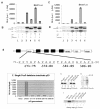The proline repeat domain of p53 binds directly to the transcriptional coactivator p300 and allosterically controls DNA-dependent acetylation of p53
- PMID: 14612423
- PMCID: PMC262654
- DOI: 10.1128/MCB.23.23.8846-8861.2003
The proline repeat domain of p53 binds directly to the transcriptional coactivator p300 and allosterically controls DNA-dependent acetylation of p53
Abstract
The transcription coactivator p300 cannot acetylate native p53 tetramers, thus revealing intrinsic conformational constraints on p300-catalyzed acetylation. Consensus site DNA is an allosteric effector that promotes acetylation of p53, suggesting that p300 has an undefined conformationally flexible interface within the p53 tetramer. To identify such conformationally responsive p300-binding sites, p300 was subjected to peptide selection from a phage-peptide display library, a technique that can define novel protein-protein interfaces. The enriched p300-binding peptides contained a proline repeat (PXXP/PXPXP) motif, and five proline repeat motifs actually reside within the p53 transactivation domain, suggesting that this region of p53 may harbor the second p300 contact site. p300 binds in vitro to PXXP-containing peptides derived from the proline repeat domain, and PXXP-containing peptides inhibit sequence-specific DNA-dependent acetylation of p53, indicating that p300 docking to both the LXXLL and contiguous PXXP motif in p53 is required for p53 acetylation. Deletion of the proline repeat motif of p53 prevents DNA-dependent acetylation of p53 by occluding p300 from the p53-DNA complex. Sequence-specific DNA places an absolute requirement for the proline repeat domain to drive p53 acetylation in vivo. Chromatin immunoprecipitation was used to show that the proline repeat deletion mutant p53 is bound to the p21 promoter in vivo, but it is not acetylated, indicating that proline-directed acetylation of p53 is a post-DNA binding event. The PXXP repeat expands the basic interface of a p300-targeted transactivation domain, and proline-directed acetylation of p53 at promoters indicates that p300-mediated acetylation can be highly constrained by substrate conformation in vivo.
Figures










References
-
- Ashraf, S. S., E. Anderson, K. Duke, P. T. Hamilton, and Z. Fredericks. 2003. Identification and characterization of peptide probes directed against PKCα conformations. J. Pept. Res. 61:263-273. - PubMed
-
- Avantaggiati, M. L., V. Ogryzko, K. Gardner, A. Giordano, A. S. Levine, and K. Kelly. 1997. Recruitment of p300/CBP in p53-dependent signal pathways. Cell 89:1175-1184. - PubMed
-
- Baptiste, N., P. Friedlander, X. Chen, and C. Prives. 2002. The proline-rich domain of p53 is required for cooperation with anti- neoplastic agents to promote apoptosis of tumor cells. Oncogene 21:9-21. - PubMed
-
- Barlev, N. A., L. Liu, N. H. Chehab, K. Mansfield, K. G. Harris, T. D. Halazonetis, and S. L. Berger. 2001. Acetylation of p53 activates transcription through recruitment of coactivators/histone acetyltransferases. Mol. Cell 8:1243-1254. - PubMed
-
- Bell, S., C. Klein, L. Muller, S. Hansen, and J. Buchner. 2002. p53 contains large unstructured regions in its native state. J. Mol. Biol. 322:917-927. - PubMed
Publication types
MeSH terms
Substances
LinkOut - more resources
Full Text Sources
Research Materials
Miscellaneous
